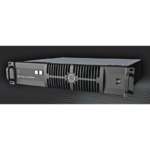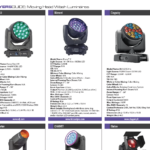
The (National Association of Broadcasters) NAB Show was held April 15–19, 2023 at the Las Vegas Convention Center and celebrated its centennial year as the preeminent conference and exhibition “driving the evolution of broadcast, media and entertainment.” 100 years ago, on October 11, 1923, the first official NAB convention was held in New York City at the Commodore Hotel with 16 radio stations represented among the 23 attendees. The 2023 gathering for the broadcasting media (radio, television, and streaming), entertainment (live broadcast and film), and production technology industries, had 1,208 exhibitors welcoming 65,013 attendees from 166 countries. “We are thrilled to have so many exhibitors, attendees, and partners from around the world join us in Las Vegas to help celebrate 100 years of innovation,” said Curtis LeGeyt, NAB President and CEO. “We thank the NAB Show community for helping us reflect on our collective experience with media and entertainment and for previewing the many innovations we’ll see within the next hundred years.” There was an incredible amount to see as promising new products and technologies were on display across three different halls. Here are a few that stood out to PLSN on the show floor.
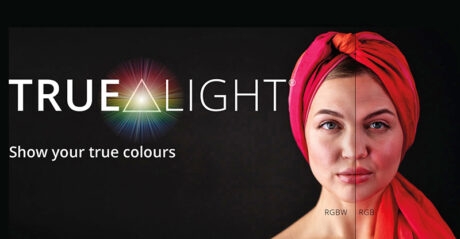
Brompton Technology TrueLight® and ROE Visual Carbon 5 RGBW LED Panel
Brompton Technology demonstrated its game-changing innovation, TrueLight®, for the first time paired with ROE Visuals brand-new Carbon 5 RGBW LED panels. The TrueLight cutting-edge technology—driven by its new Tessera G1, the industry’s most powerful receiver card—enables full calibration of the pixels and control of the light spectrum emitted by an LED panel with a broader spectral output, by utilizing extra emitters in addition to the standard RGB format. This results in unparalleled color rendering, illuminating individuals and objects with increased realism.
Attendees witnessed TrueLight in action during demos in the Brompton booth. These demos were made in collaboration with ROE Visual who showcased their new Carbon 5 RGBW panel powered by TrueLight. Carbon 5 RGBW is the first panel of its kind calibrated by Brompton’s Hydra to offer a fourth emitter providing a broad spectrum white.
TrueLight leverages Brompton’s proprietary Dynamic Calibration technology, performed by the company’s Hydra advanced measurement system. This is the only system on the market capable of providing complete spectrally-aware calibration for extra emitters to ensure that colorimetric precision, full color and luminance correction are applied on a per-pixel basis, delivering the image quality necessary for direct-view applications, including reflections. All possible RGBW spectral mixes are fully corrected, maintaining calibration accuracy at all times.
“Thanks to TrueLight technology, users can dynamically adapt the spectral behavior using controls in the processor UI, including optionally disabling the ‘W’ LEDs for conventional fully-calibrated RGB-only operation,” explains Cesar Caceres, Brompton’s Product Lead.
Frank Montero, Managing Director at ROE Visual US comments, “ROE is very proud to be investing in new technologies with Brompton. Brompton and ROE have long been successful partners in live events and virtual production. Our rapid collaboration on Carbon 5 RGBW is just a small measure of what we can accomplish together.”
Chris Deighton, Brompton’s CTO, comments: “There has been increasing interest in broader spectral output from LED panels, and we were determined to meet this demand without compromising the existing levels of image quality and flexibility expected by Brompton users. The immense processing power available in the G1 receiver card means TrueLight® can perform spectrally-aware full-color per-pixel calibration of all four RGBW LED colors, with fully dynamic controls to adapt the spectral behavior in real-time. We look forward to seeing how the industry adopts this technology to achieve ever more realistic in-camera visual effects.”
“TrueLight technology unlocks a whole new realm of possibilities for applications that demand uncompromising image quality and color accuracy,” concludes Caceres. “Whether it’s virtual production, XR, simulation, theater, fixed corporate installations, fashion, or retail, TrueLight represents an industry-changing solution for scenarios where the screen is used as a lighting source. TrueLight is the perfect choice for high-end applications that require nothing but the best.”
www.bromptontech.com and www.roevisual.com
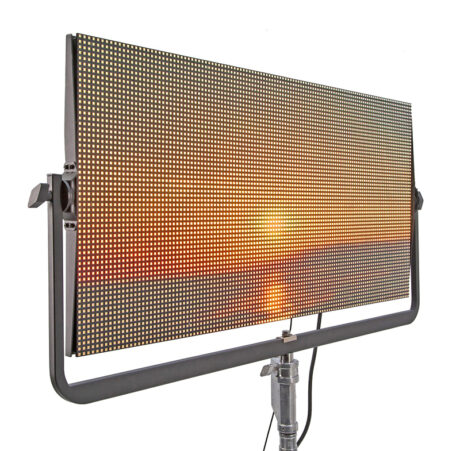
Kino Flo: MIMIK 120
Kino Flo, a part of the CHAUVET company, was highlighting its MIMIK 120, an image-based video lighting tile solution. Some of the MIMIK units were hung with accessory mounting yokes—like studio lights—around the sides, and some mounted flush with each other to create on overhead LED ceiling, over a built Ferris wheel car, so attendees sitting in the car would appear in a virtual ‘Ferris wheel’ being displayed on an LED screen.
The MIMIK mirrors the onscreen video content while applying a higher tonal and color rendering range. MIMIK is designed to deliver extended spectral bandwidth and cinematic color fidelity when lighting talent and set elements in virtual production environments.
Patented Kino Flo technology translates an incoming RGB video signal into five individual emitters (warm white (2700K), cool white (6,500K), red, green, and blue), generating synchronized foreground lighting that creates the utmost realism on virtual sets.
Embodied in a lightweight carbon fiber frame, MIMIK adapts to on-set configurations with easy mobility. Controlled by the Megapixel VR HELIOS LED processor, MIMIK expands real-time and post-production options, delivering 8,000 NITS, along with the ability to shoot as high as 960 frames per second and offer as many as 32 Alpha channels at 30 frames per second.
This full spectrum LED image-based lighting solution enables latency-free synchronization to an LED volume along with the versatility of optional control from a lighting console.
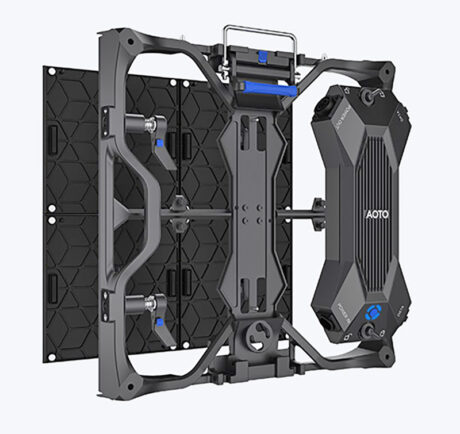
AOTO Electronics: RM Series LED Panel
AOTO Electronics was honored with an NAB product award in the Digital Signage & Display Systems category for its RM Series of fine pixel pitch LED display that’s designed for virtual production. AOTO displayed the RM series product to attendees showing virtual worlds created by Content Creator Vello Virkhaus’ XiteLabs.
The RM Series from AOTO has a pixel pitch of 1.56mm or 2.6mm and features a simple structure, lightweight panel, fast assembly, and high reliability. By combining the mini components, high robustness features and specially designed structure, the RM series is designed for dependability. Due to the use of IMD packaging technology, the products are extremely stable and reliable. One IMD is four times stronger than the conventional SMD products. The contrast ratio is significantly enhanced by smaller surface reflection and ultra-black color. With brightness enhancement technology and 26-bits color control capability, the visual effect of products can reach HDR levels. The design of the panels allows for both concave and convex installations. Front and rear access for maintenance lowers the operational cost and increases efficiency, and the fast lock design supports fast installation. Made with magnesium alloy material, the RM panel weighs less than 16.5 lbs. (7.5kg).
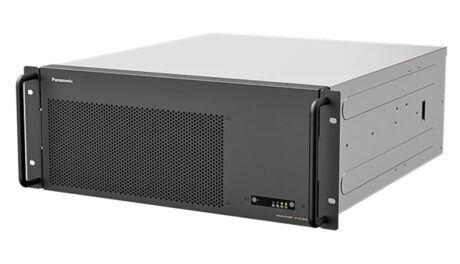
Panasonic Connect: KAIROS Live Production Platform
Panasonic Connect North America demonstrated KAIROS, its live video production platform. It now incorporates a new cloud-based solution along with recent hardware and software updates. These enhancements will expand the platform’s ability to support more complex productions by streamlining workflows and giving production professionals greater flexibility to deliver rich content.
The KAIROS lineup expanded with new software control and hardware as Panasonic Connect also introduced the new KAIROS Touch Control Panel as well as showcased the next generation of KAIROS hardware—the AT-KC200 and AT-KC2000. The AT-SFTC10 KAIROS Touch Control Panel (TCP) can be implemented with a touch-panel PC to enable touch-panel control from a multi-viewer to be used for switching, macro, scene selection, clip playback and other operations in the KAIROS system.
The AT-KC200 and AT KC2000 cores feature a 4RU chassis design, and larger RAM capacity for a more powerful internal-playback system. The KC200’s internal clip player has twice the capacity of the KC1000, enabling playback of two hours of high-quality HD video (440 Mbps) with embedded audio and alpha channel. The KC2000’s Clip Player has the capacity for over 4.5 hours of high-quality content (440 Mbps), eliminating the need for an external playback server in many instances.
The KC2000 will also support 200 Gbps of ST 2110 connectivity via a pair of QSFP network connections. Output capacity will expand with ten independent 4K outputs, and four multi-viewer outputs, each with UHD resolution. Combining the flexibility of the existing KAIROS system with this increase in capacity, the KC2000 will become the new flagship core mainframe of the KAIROS lineup.
https://na.panasonic.com/us/panasonic-connect
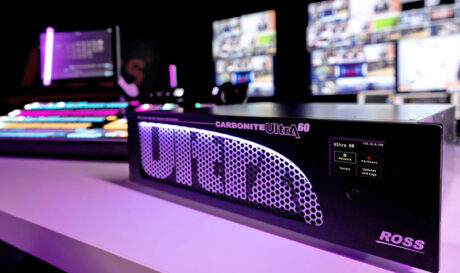
Ross Video: Carbonite Ultra 60 Switcher
Ross Video had a massive 10,000 sq. ft. booth at NAB and was showing off a lot of new products, technologies, and solutions. Ross Video also had one of its products honored with an NAB product award—the Carbonite Ultra 60, a mid-range switcher that offers big switcher performance in a cost-effective hardware platform. The Carbonite Ultra 60 features modular I/O boards that provide up to 60 Inputs and 25 Outputs and three full MEs in HD or UHD.
Of note was its integrated LED experience. In 2021, Ross acquired D3LED, adding core LED display technology to its portfolio. Building upon that technology, Ross launched two new families of LED display, processing engines, and remote power at the show. Applications for these products include live events, virtual production, extended reality, and digital signage.
Ross is expanding its solutions for Extended Reality (XR) production. With LED displays, robotic camera systems, camera tracking, and the latest in rendering performance, Ross now has the necessary pieces to complete its XR puzzle. Live demonstrations showcased the benefits XR can deliver—flexible studio space, reduced set costs, faster production, and higher quality output. The company was also previewing Voyager 5.1, which harnesses the latest Unreal game engine and new Nanite dynamic polygon and Lumen dynamic lighting technologies.
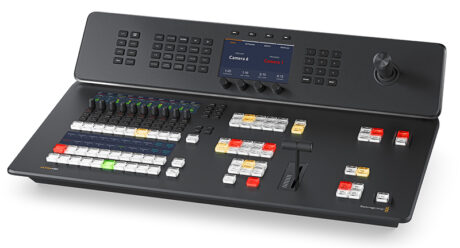
Blackmagic Design: ATEM Television Studio 4K8
Blackmagic Design had a range of new products as well as updated software releases to highlight in its NAB Booth including a new URSA Broadcast ENG kit; and Blackmagic Cloud Dock 2 and Cloud Dock 4, both of which work with SSDs and U.2 disks.
In addition, attendees could try out the new ATEM Television Studio 4K8, a new live production switcher that combines all the broadcast features of the ATEM Television Studio HD with additional support for Ultra HD standards up to 2160p60. The ATEM 4 M/E Constellation 4K is a new Ultra HD model of the ATEM Constellation family with 40 x 12G-SDI standards converted inputs with support for standards up to Ultra HD 2160p60. They now have a free update of DaVinci Resolve 18.5 (beta available now) which adds new AI tools, over 150 feature upgrades such as Resolve FX relight, speech to text editing, automatic subtitling, AI audio classification, Universal Scene Description file support, new menus on the Cut page that let customers work faster while allowing more time for being creative, and Fusion USD support for faster workflows. The Blackmagic URSA Mini Pro 12K OLPF adds a high performance optical low pass filter to the 12K Super 35 image sensor. The OLPF reduces artifacts such as moiré and aliasing, while preserving the color and critical image detail.
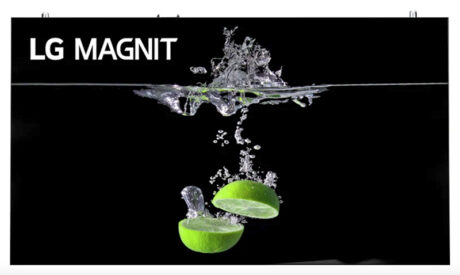
LG Electronics: LG Magnit
In the LG Electronics booth, they were highlighting their new LG MAGNIT Micro LED screen product. Using Chip on Board (COB) LED technology, removing the package surrounding the RGB LED chips, and applying LG’s Full Black Coating technology, the LG MAGNIT screen in the booth delivered much deeper black than conventional packaged LED screens. It enhanced the color vividness, but also made the details which are normally hidden in the shadows appear. The solid black LG MAGNIT also creates a high contrast ratio which is a key part of the picture quality. The difference between the dark parts and the light parts is clearly great, making every part of the content distinctive. It was a much more immersive experience. The screen in the booth had a pixel pitch of 1.5mm, but they are looking to go even tighter, like sub 1mm. It offers accurate colors, a wide viewing angle, and much better picture quality for use with set extensions in virtual and XR production. They are looking for it to be used for rental and staging applications as it has stacking and hanging systems available, as well as the ability to curve the screen.
